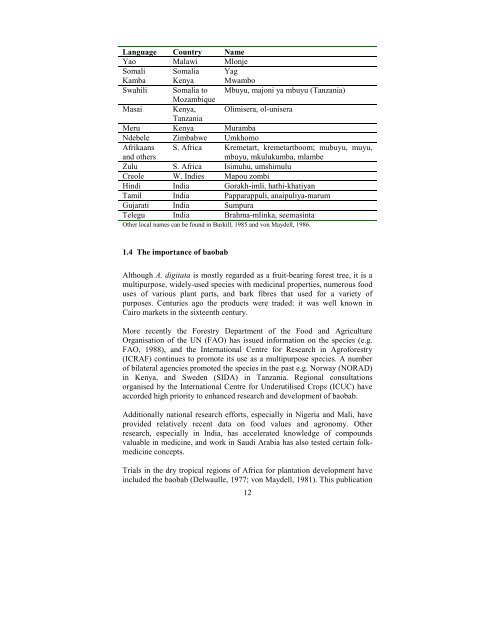Baobab Monograph.pdf - Crops for the Future
Baobab Monograph.pdf - Crops for the Future
Baobab Monograph.pdf - Crops for the Future
Create successful ePaper yourself
Turn your PDF publications into a flip-book with our unique Google optimized e-Paper software.
Language Country Name<br />
Yao Malawi Mlonje<br />
Somali Somalia Yag<br />
Kamba Kenya Mwambo<br />
Swahili Somalia to Mbuyu, majoni ya mbuyu (Tanzania)<br />
Mozambique<br />
Masai Kenya, Olimisera, ol-unisera<br />
Tanzania<br />
Meru Kenya Muramba<br />
Ndebele Zimbabwe Umkhomo<br />
Afrikaans<br />
and o<strong>the</strong>rs<br />
S. Africa Kremetart, kremetartboom; mubuyu, muyu,<br />
mbuyu, mkulukumba, mlambe<br />
Zulu S. Africa Isimuhu, umshimulu<br />
Creole W. Indies Mapou zombi<br />
Hindi India Gorakh-imli, hathi-khatiyan<br />
Tamil India Papparappuli, anaipuliya-marum<br />
Gujarati India Sumpura<br />
Telegu India Brahma-mlinka, seemasinta<br />
O<strong>the</strong>r local names can be found in Burkill, 1985 and von Maydell, 1986.<br />
1.4 The importance of baobab<br />
Although A. digitata is mostly regarded as a fruit-bearing <strong>for</strong>est tree, it is a<br />
multipurpose, widely-used species with medicinal properties, numerous food<br />
uses of various plant parts, and bark fibres that used <strong>for</strong> a variety of<br />
purposes. Centuries ago <strong>the</strong> products were traded: it was well known in<br />
Cairo markets in <strong>the</strong> sixteenth century.<br />
More recently <strong>the</strong> Forestry Department of <strong>the</strong> Food and Agriculture<br />
Organisation of <strong>the</strong> UN (FAO) has issued in<strong>for</strong>mation on <strong>the</strong> species (e.g.<br />
FAO, 1988), and <strong>the</strong> International Centre <strong>for</strong> Research in Agro<strong>for</strong>estry<br />
(ICRAF) continues to promote its use as a multipurpose species. A number<br />
of bilateral agencies promoted <strong>the</strong> species in <strong>the</strong> past e.g. Norway (NORAD)<br />
in Kenya, and Sweden (SIDA) in Tanzania. Regional consultations<br />
organised by <strong>the</strong> International Centre <strong>for</strong> Underutilised <strong>Crops</strong> (ICUC) have<br />
accorded high priority to enhanced research and development of baobab.<br />
Additionally national research ef<strong>for</strong>ts, especially in Nigeria and Mali, have<br />
provided relatively recent data on food values and agronomy. O<strong>the</strong>r<br />
research, especially in India, has accelerated knowledge of compounds<br />
valuable in medicine, and work in Saudi Arabia has also tested certain folkmedicine<br />
concepts.<br />
Trials in <strong>the</strong> dry tropical regions of Africa <strong>for</strong> plantation development have<br />
included <strong>the</strong> baobab (Delwaulle, 1977; von Maydell, 1981). This publication<br />
12

















